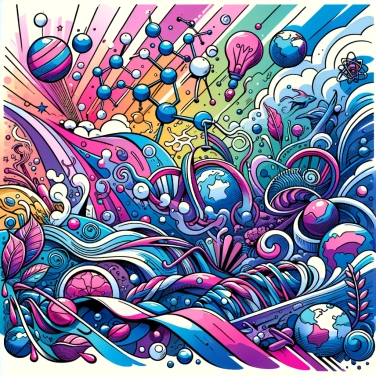Water freezes at zero degrees Celsius because it is at this temperature that water molecules slow down enough to form an orderly solid structure, what we call ice.

Water has several astonishing characteristics, such as the fact that it is one of the few substances that increases in volume when it freezes. Usually, substances become denser when cooled, but water is different: its maximum density occurs at around 4°C. Below this temperature, it starts to expand, which is why ice floats on the surface of ponds or lakes. This peculiarity is caused by the famous hydrogen bonds, which structure water molecules in a rather unique way. Another characteristic: water has a high heat capacity, meaning it can store a lot of heat without its temperature changing quickly. This phenomenon explains why oceans take time to heat up or cool down, thereby regulating the climate on Earth.
Water molecules love to stick together due to a phenomenon called hydrogen bonds. Essentially, the oxygen atom strongly attracts the small hydrogen atoms from neighboring molecules, creating a sort of tight network. When the temperature drops to zero degrees Celsius, these bonds become more stable, stronger, and form a regular crystal structure. This well-organized arrangement causes the water to lose energy and gradually transition from a disordered liquid state to a highly structured solid state: ice. It is indeed because of these organized hydrogen bonds that ice takes up more space than liquid water, which is why pipes can burst in winter.
The freezing point of water that we know at 0°C corresponds to normal atmospheric pressure, which is about 1 atmosphere at sea level. When this pressure is altered, it changes as well. For example, if you increase the pressure, the freezing point decreases slightly: in other words, under higher pressure, water can freeze a little below 0°C. Conversely, decrease the atmospheric pressure (as at high altitudes), and water freezes at a temperature just above 0°C, but honestly, this variation remains minor in everyday life. If you go high into the mountains, even at several thousand meters, the freezing point will remain almost stable around 0°C. This phenomenon is related to the surprising fact that ice occupies a larger volume than liquid water, a somewhat odd characteristic of water directly linked to its hydrogen bonds.
Water freezes exactly at 0 °C, but other everyday liquids fall into different categories: for example, alcohol (ethanol) remains liquid much lower, freezing only around -114 °C. Conversely, olive oil starts to solidify around -6 °C, solidifying more easily than alcohol but less easily than water (handy to know if you keep your bottle near your freezer!). Mercury, found in some thermometers, becomes solid at about -39 °C, which explains why mercury thermometers stop working properly in extreme cold. Each substance therefore has its own temperature preferences for transitioning to solid, and water, with its freezing point at exactly zero, makes life easier for calibrating thermometers!
When you put ice cubes in your soda, they float on the surface rather than sinking because water expands as it freezes and becomes less dense than liquid water. Another example is when winter arrives; small puddles of water can freeze right at 0°C, but larger bodies of water like lakes or the sea take much longer to freeze due to their mass and salinity. At home, you can test this by filling a small bottle to the brim before putting it in the freezer: after a few hours, you'll notice that it may be deformed or even burst, because water takes up about 9% more space when it freezes. A simple yet telling experiment! This also explains why unprotected pipes sometimes crack during freezing periods.
Unlike most substances, water expands when it freezes, increasing its volume by about 9%. This explains why frozen water can damage pipes in winter.
Pure water can remain liquid at temperatures below zero degrees Celsius in the absence of particles or impurities. This is called "supercooling," a phenomenon that sometimes explains why water stays liquid well below its official freezing point.
On Earth, ice floats on top of liquid water because it is less dense. This uniqueness has allowed aquatic life to survive during glacial periods, with the frozen surface protecting the lower layers of water from the cold.
Under standard atmospheric pressure, water boils at 100 °C and freezes at 0 °C. But did you know that if you change the pressure, these temperatures can vary significantly? For example, at high altitudes, water boils at a temperature lower than 100 °C.
Yes, unlike most other substances, water expands when it freezes. This expansion is due to hydrogen bonds that arrange themselves into an open crystalline structure, causing ice to take up more volume than liquid water, which is why it floats on the surface.
Ice floats because it is less dense than liquid water. In its solid state, water molecules adopt an ordered crystalline structure that takes up more space, thereby decreasing their density compared to the more compact liquid water.
Yes, atmospheric pressure has a slight influence on the freezing point. When the pressure increases significantly, the freezing point decreases slightly. However, this variation remains very small under standard atmospheric conditions.
Water reaches its maximum density at around 4 °C. When the temperature drops further, the less dense, colder water rises to the surface. As a result, the water at the surface cools down to 0 °C and freezes, forming floating ice on the surface, which protects the depths from freezing completely and thus preserves aquatic life.
In certain circumstances, water can experience a phenomenon called supercooling: it remains liquid below the normal freezing point (0 °C). This typically occurs due to a lack of impurities or particles that would trigger crystallization.

No one has answered this quiz yet, be the first!' :-)
Question 1/5